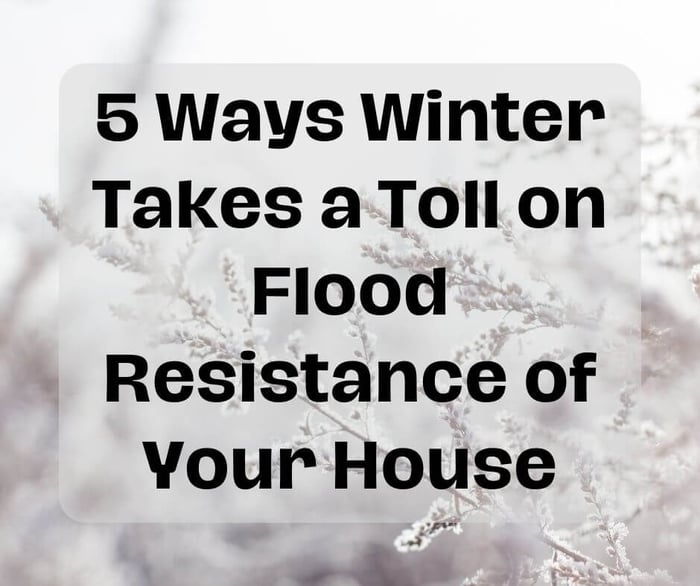Winter can be a magical time with snowflakes, hot cocoa, and cozy nights by the fire. However, it also brings unique challenges, especially when it comes to protecting your home from floods. While flood resistance might not be the first thing on your mind during the colder months, neglecting it can lead to serious consequences. Here are five ways winter can take a toll on the flood resistance of your house:
Frozen pipes.
One of the most common issues during the winter is frozen pipes. When water freezes inside your pipes, it expands, putting immense pressure on the pipes and increasing the risk of them bursting. Burst pipes not only cause immediate water damage but can also compromise your home's flood resistance by weakening walls and foundations.
Here is what you can do:
- Insulate Pipes: Insulate any exposed pipes, especially those in unheated areas like crawl spaces, basements, and attics. Pipe insulation sleeves or wrapping can help prevent them from freezing by maintaining a higher temperature.
- Seal Cracks and Openings: Seal any cracks or openings in exterior walls, floors, or ceilings to prevent cold air from reaching pipes. Use caulking or weather-stripping to seal gaps around windows, doors, and vents.
- Keep Interior Temperatures Consistent: Keep your home heated to a consistent temperature, even when you're away. Set your thermostat to at least 55°F (13°C) to ensure that the interior remains warm enough to prevent pipes from freezing.
- Allow Faucets to Drip: On particularly cold nights, allow faucets to drip slightly. Running water, even at a trickle, can help prevent pipes from freezing by relieving pressure buildup.
- Open Cabinet Doors: For pipes located under sinks or in cabinets, open the cabinet doors to allow warm air to circulate around the pipes. This can help prevent them from freezing, especially in kitchens and bathrooms.
- Drain Outdoor Faucets and Sprinkler Systems: Before winter sets in, disconnect and drain outdoor hoses, faucets, and sprinkler systems. Shut off the water supply to outdoor faucets and install frost-proof hose bibs if possible.
- Use Heat Tape or Cable: Consider installing heat tape or cable on vulnerable pipes, especially those exposed to extreme cold or located in uninsulated areas. Heat tape provides an additional layer of protection by generating heat to keep pipes from freezing.
- Keep Garage Doors Closed: If your garage has water supply lines, keep the garage doors closed, especially during extremely cold weather. This helps maintain warmer temperatures inside the garage and prevents pipes from freezing.
- Inspect Insulation: Regularly inspect the insulation in your home, particularly in attics, crawl spaces, and basements. Ensure that insulation is properly installed and in good condition to prevent cold air infiltration.

By taking these preventive measures, you can significantly reduce the risk of frozen pipes bursting and protect your home from water damage and compromised flood resistance during the winter months.
Snowmelt Overload
As temperatures rise during the winter, accumulated snow starts to melt. While a picturesque snowfall may seem harmless, the resulting snowmelt can overwhelm drainage systems and cause flooding. If your home's drainage isn't properly maintained or if snow accumulates near your foundation, it can seep into your basement or crawl space, compromising your flood resistance.
To address the issue of snowmelt overload and protect your home from potential flooding during the winter, investing in flood barriers can be an effective solution. Flood barriers are versatile, easy-to-install systems designed to safeguard your property against rising water levels. Here's why they can help mitigate the risks associated with snowmelt overload:
- Easy Installation and Removal: Flood barriers are engineered for quick and hassle-free installation, allowing you to set them up rapidly when needed. This means you can deploy them in anticipation of snowmelt or forecasted heavy rainfall, providing immediate protection for your home. Additionally, their ease of removal ensures that you can store them away when the threat has passed without the need for extensive labor or specialized equipment.
- Secure and Seal House: Flood barriers are designed to create a watertight seal around vulnerable entry points such as doors, windows, and garage openings. By effectively blocking the flow of water, they prevent snowmelt or runoff from infiltrating your home's interior and compromising your flood defenses. This secure sealing mechanism provides peace of mind, knowing that your property is safeguarded against potential water damage.
- Versatile and Customizable: Flood barriers come in various sizes and configurations to suit different property layouts and flood risk levels. Whether you need protection for a single entryway or perimeter defense for your entire property, there are flood barrier options available to meet your specific requirements. Additionally, some systems offer flexibility in height adjustment, allowing you to customize the barrier's height based on the anticipated water level, further enhancing its effectiveness.
- Durable and Reliable: High-quality flood barriers are constructed from robust materials designed to withstand prolonged exposure to harsh weather conditions, including freezing temperatures and snow accumulation. Their durability ensures long-term reliability, providing repeated protection season after season without compromising performance. With proper maintenance and care, flood barriers can serve as a dependable defense against snowmelt overload and other flood-related hazards.
$949.00
DAM EASY® FLOOD GATE - DOOR DAM Floods are becoming more common around the world. What was once a 100-year phenomenon is now a seasonal trend that homeowners must deal with. That’s EXACTLY why you need this Dam Easy Flood… Read MoreFlood Barrier Door Dam - Ultimate Flood Gate

By investing in flood barriers, you can fortify your home's defenses against snowmelt overload and effectively mitigate the risk of flooding during the winter months. With their easy installation, secure sealing, versatility, and durability, flood barriers offer a practical and reliable solution to safeguard your property and belongings from water damage.
Thawing and Refreezing
Winter weather often brings fluctuations in temperature, causing snow and ice to thaw during the day and refreeze overnight. This cycle can exacerbate existing cracks in your home's foundation, walls, or driveway. The expansion and contraction from freezing and thawing weaken these areas, making them more susceptible to water intrusion during heavy rains or snowmelt events.

To improve flood resistance and mitigate the effects of thawing and refreezing cycles during the winter, consider implementing the following strategies:
- Foundation Inspection and Repair: Conduct a thorough inspection of your home's foundation for any existing cracks or vulnerabilities. Seal any cracks with appropriate sealants or epoxy to prevent water intrusion. Addressing foundation issues proactively can help reinforce its integrity and minimize the risk of water seepage during thawing and refreezing cycles.
- Proper Drainage Systems: Ensure that your property has adequate drainage systems in place to manage water runoff effectively. Clean and maintain gutters, downspouts, and drainage ditches to prevent blockages and allow water to flow away from your home's foundation. Consider installing French drains or grading your yard to redirect water away from vulnerable areas.
- Insulation and Moisture Barrier: Proper insulation and moisture barrier installation can help regulate temperatures and moisture levels within your home's walls and foundation. Insulate exterior walls and crawl spaces to minimize temperature fluctuations and reduce the risk of freezing and thawing-induced damage. Install vapor barriers in basements and crawl spaces to prevent moisture intrusion.
- Landscaping Practices: Modify your landscaping to minimize the impact of thawing and refreezing cycles on your property. Avoid planting shrubs or trees too close to your home's foundation, as their roots can exacerbate cracks and weaken structural integrity. Consider adding mulch or gravel around the perimeter of your home to improve drainage and prevent soil erosion.
Want to know more about flood resistance solutions for your property? Dam Easy is here for you! Contact us today, and we will help you evaluate the flood risks of your house and choose the best flood control solutions that will work perfectly for you. Together, we will make sure that your house is safe and sound in the face of the most severe flooding.
Flood safety is Dam Easy!



